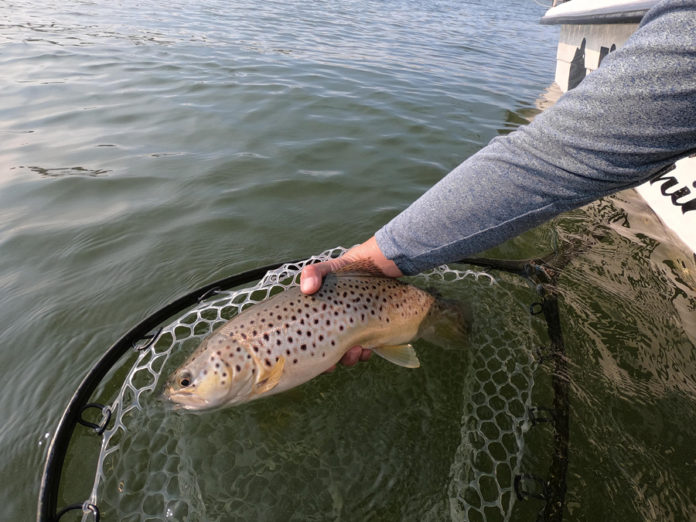Written by: Jim Elias, Fish Mammoth guide service
All photos by Jim Elias
I’ve been guiding on Lake Crowley, in the Mammoth Lakes region of California, for more than a decade, and in that time, I’ve learned a lot about how to find trout in still waters, even during the heat of summer, and how to catch them on fly. Having discussed strategies for finding fish in Part 1 of this series, let’s turn to specific techniques for presenting flies once you’ve identified a likely spot.
Presentation
When I first started out guiding, midsummer heat would have us fishing 12- to 15-feet deep at most. As the summers get warmer here–and especially when combined with an extended drought–the fish are moving even deeper, so making casts into 20-plus feet of water is now fairly commonplace. Needless to say, getting a fly down that deep–while maintaining control over your rig–requires some special equipment and techniques.
Before getting into more technical details, however, the easiest way to improve your stillwater fishing is to simply switch to fluorocarbon tippet. When your flies are sitting motionless in the water column, the fish have considerably more time to inspect them and make a decision. I’ve done many side-by-side tests with identical rigs, and the fluoro always gets more takes.

I use sinking lines when possible, but most days, I’m fishing under a strike indicator. I’ve been dabbling in drop-shot and naked rigs, but they just don’t seem to work as consistently as the bobbers. While a standard setup will reliably get flies down to about 12 feet, nymphing down to 20 feet or more requires the use of a “breakaway” or sliding indicator. Both are designed to allow your extremely long leader to be retrieved into the rod guides while landing fish or casting. I make a sliding rig that can be fished at depths of 15 to 35 feet.
Generally, I will change the depth I’m fishing before changing my flies or moving to a different spot, especially if I can see fish on my fish-finder screen. Mid-column currents can sometimes be an issue, especially when fishing deep, so more weight and a bigger bobber might be necessary to get your flies down into the strike zone.

I do a lot of bobber-watching. I know that’s not everyone’s favorite, but it catches fish. The most important thing about fishing with a strike indicator is that you can’t take your eyes off the bobber, even for a second. I’ve seen too many bobbers dip down as their owner was checking out that cool cloud or wondering what type of bird that was. I have just two rules on my boat:
Rule 1: Watch your indicator.
Rule 2: See Rule 1.
Seriously, though, big-lake fishing is all about diligence, patience, and building on past experience. I’ve been fishing Crowley for over a decade, and I’m still learning, so get out there, experiment, and enjoy the process.
Jim Elias is owner and operator of Fish Mammoth guide service in Mammoth Lakes, California.
Credit: Source link






























